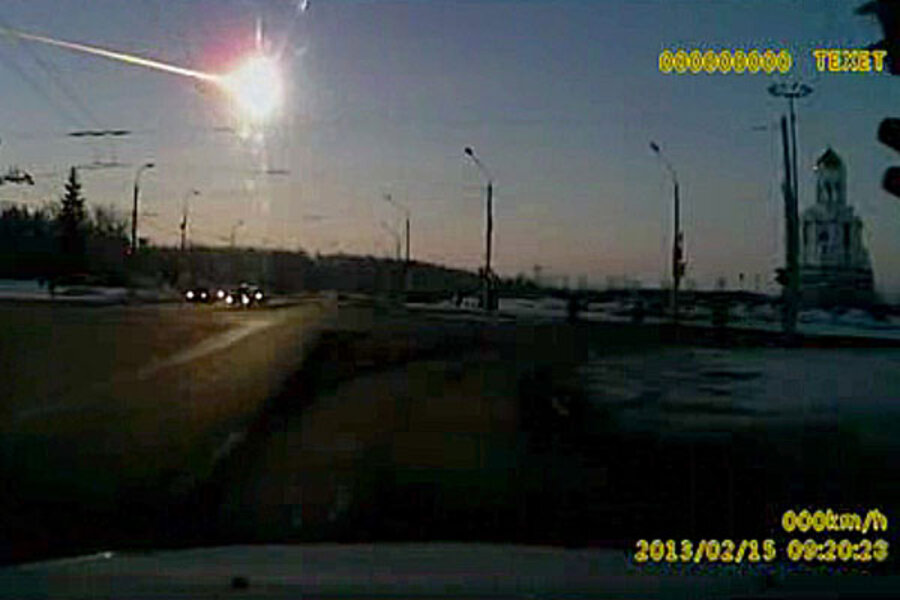Meteor that bombed Russia left telltale tracks seen from space
Loading...
When a huge meteor blazed across the sky over the Russian city of Chelyabinsk in February, dashboard cameras in Russians' cars weren't the only eyes on the sky recording the event.
Weather satellites operated by the US as well as countries in Europe and Asia also captured the meteor's fall, and astronomers have now gone back to cull those data, tracing a debris trail in enough detail to allow them to reconstruct the object's trajectory and orbit, according to a new study.
In case of the Chelyabinsk event, scientists had already worked out the meteor's trajectory and calculated an orbit using videos from Russia dashboard cams. But their success in now replicating that feat with satellite data represents a promising new tool. After all, not every meteor will streak through the sky in a region filled with dash cam, and this new method could help scientists predict potentially damaging meteor strikes in the future.
It's important to establish an object's orbit, because astronomers can look along that orbital path to see if the first object to arrive has others coming in behind it – and, if so, what sort of risk they present. This is especially true when the meteor arrives without warning, as the Chelyabinsk meteor did, researchers say.
The vast majority of Chelyabinsk-scale objects, which can inflict significant damage, remain undiscovered, notes Donald Yeomans, a researcher at NASA's Jet Propulsion Laboratory in Pasadena, Calif., who manages NASA's Near-Earth Object Program Office.
In principle, weather satellites could help fill big geographic gaps in the ability to directly observe impactors, says Steven Miller, deputy director of the Cooperative Institute for Research in the Atmosphere at Colorado State University in Fort Collins, who led the team that conducted the study..
Dr. Yeomans agrees. “The satellites can see where ground-based observers can't, and the satellite coverage would be far more complete than the observations from ground-based observers.”
Moreover, the satellites can provided information on the energy released via the near-infrared and heat sensors they carry.
The upshot: If weather-satellite providers could add the kind of analysis Dr. Miller and his colleagues performed, astronomers would have a better handle on the numbers of these smaller objects striking Earth and better understand the kinds of orbits they occupy, Yeomans writes in an e-mail.
The information would also help guide researchers to impact sites, where they could hunt for fragments and analyze them, he adds.
Indeed, last Wednesday, divers helped retrieve a rock weighing more than 1,250 pounds out of Lake Chebarkul. The rock is thought to be a fragment of the Chelyabinsk meteor.
The original object is thought to have been a small asteroid, tipping the scales at roughly 12,000 tons, according to estimates from NASA. Nearly 60 feet wide, the meteor exploded 14.5 miles above the city, The shock wave from the air burst shattered windows throughout the Chelyabinsk region, injuring nearly 1,500 people. Another, larger asteroid buzzed Earth 16 hours later, passing within 17,200 miles of the planet – inside the orbits of geostationary satellites.
Miller, a satellite meteorologist, says that once he convinced himself that the videos appearing on the evening news that night weren't a hoax, he immediately thought to check whether weather satellites had picked up the event.
The trail of debris the meteor left in its wake “looked very much like the aircraft contrails that we see in the sky all the time,” he says. He and colleagues hunted for images from weather satellites that covered the area at the time.
Miller and four colleagues from Colorado State, the University of Wisconsin, and the National Oceanic and Atmospheric Administration selected images from two satellites – Europe's Meteosat-9 for the higher-altitude view and a Pentagon weather satellite for the view from low-Earth orbit. Both captured the streak of debris, including a feature dubbed the turret. It's akin to mini thunderhead that formed as the meteor exploded, its heat forming a convective cloud above the debris trail and giving the trail the look of a worm with a mole on it.
Each satellite viewed the event from a different angle, so Miller's team has to adjust for that. When the researchers did that, they found that their best estimate of the track carried the shattered remains of the meteor over Lake Chebarkul and closely matched the track researchers had estimated earlier from the dash-cam videos.
Miller notes that weather satellites are not optimized to include meteor hunting on their agendas. Still, they can be harnessed for the task, he says. A new generation of weather satellites will be even better, he suggests.
For instance, the US is building four news weather and environmental satellites known by their acronym GOES-R. They will carry lightning detectors that could double as meteor detectors, Miller says. Unlike the instruments on the satellites Miller's team tapped, these lightning detectors relay their data to Earth as soon as the data are taken. This would speed the ability of scientists to answer some of their initial questions about a Chelyabinsk-like event or larger.








